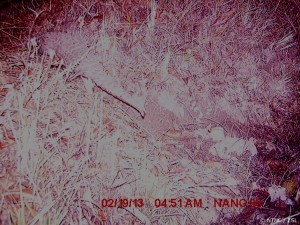
In and around Nangkholyang, I’ve deployed 10 infra-red sensor detector camera traps in locations that the local 
We’ve also been collecting information from the local community and it seems that, over the last 5 to 6 years, villagers have been becoming aware of the value of pangolin scales. Traders have been coming to the village offering money for pangolin scales. Locals search for pangolins when they’re in their burrows by making a fire in the burrow, pouring water down the burrow, inserting sharp pointed weapons into the burrows, and by digging the burrows up. Using these methods, results from key informants suggest that approximately 200 pangolins have been killed in the local area in the last 2 years.
Given these alarming figures, I have been focusing on building conservation awareness among the locals and schools students. For example, we arranged a school teaching programme for teachers and students in classes 6 to 12 to share information about the pangolin. We also tried to collect information from the students by holding an essay competition on the topic of “The role of youth in the conservation of the Chinese pangolin”. Being local residents, the student knew of the Chinese pangolin but they did not know that it was listed as Endangered by the IUCN or that it was of global conservation significance. This was our first step in building conservation awareness.


Armed with the information I had collected from the local community, I visited Taplejung District Headquarters where I gave a presentation about the Chinese pangolin to the Kangchenjunga Conservation Area Management Council, District Forest Office and some journalists. Being on the border with China and India, Taplejung is a key transit point for illegal traders so I focused my presentation on highlighting trade issues. After the presentation, I gave a 15 minute interview to the local radio station “Radio Taplejung” and the Nepali national daily “Gorkhapatra” also published news regarding our project.
This month is especially exciting because I’m going present my pangolin work at the Student Conference on Conservation Science (SCCS) in Cambridge, UK. Following the conference I’m going to spend a month at ZSL and thoroughly analyze all the data I’ve collected so far. I’m also going to work with key members of the IUCN Pangolin Specialist Group to ensure my work contributes to the global conservation of the Chinese pangolin.
To learn more about the EDGE Fellowship programme, please click here.